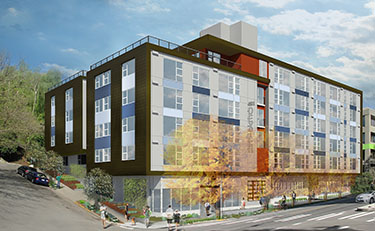|
Subscribe / Renew |
|
|
Contact Us |
|
| ► Subscribe to our Free Weekly Newsletter | |
| home | Welcome, sign in or click here to subscribe. | login |
Real Estate
| |
 Brian Miller Real Estate Editor |
September 29, 2016
On the Block: Does density have to bring displacement?
Few topics are more fraught in Seattle's hot housing market than gentrification and displacement. As the city's median income rises, The Seattle Times recently reported, the percentage of low-income households is dwindling. Those people may be getting richer, a nice thought; or they may simply be leaving for cheaper rents beyond the city limits.
Of particular concern — and confusion — for housing advocates is how to measure the tremendous inflow of new Seattle residents, mostly renters, versus long-established tenants who had been paying lower rents in older, rundown apartment buildings. Both free-marketeers and affordabilistas agree that Seattle has created an awful lot of housing during the last decade. And yet they also agree it's still not enough.
Between 2005 and 2014, city building permit records show, Seattle had about 48,000 housing units created and about 5,500 demolished — meaning a net increase of about 42,500. During the same period, the city added about 77,000 residents, not all of whom live alone.
What percentage of those new units were affordable, much less low-income, is harder to judge. The city's Office of Housing only tracks units where it had a financial interest (be it subsidy or tax credit), which is to say most but not all affordable housing. Seattle Housing Authority keeps separate records. A few projects go forward without local money. Then there's the gray area of “naturally occurring affordable housing” — uncounted older properties where rents remain low.
From 2005 to 2014, the Office of Housing reports a net increase of about 7,000 affordable units. During the same period, SHA had a net gain of about 350 affordable units. Combined with Office of Housing numbers, that's about 17 percent of the net increase in overall Seattle housing units. But those are rough DJC estimates only.
Panelists at a recent AIA-sponsored discussion tried to interpret those figures. The talk was called “Growing a City: Density, Displacement and Policy in an Urbanizing Seattle,” and it was part of the recent Seattle Design Festival. The panel was journalist Erica C. Barnett, Alex Brennan of Capitol Hill Housing and Roger Valdez of Smart Growth Seattle.
People move and households change faster than U.S. Census data can track them, noted Brennan. If people are being displaced, he said, where are they going, and how far are they from their old neighborhoods? No one knows.
“We don't have the data,” said Valdez, who lobbies for developers and opposes linkage fees to create affordable housing.
Moreover, under the city's current incentive zoning, developers are already building new affordable housing — or contributing fees toward construction — and it all gets folded somewhere into that 48,000 number. Though CHH only builds affordable apartments (sometimes with for-profit partners), Brennan struck a pro-growth note that meshed with Valdez's position: “We need to build a lot of new housing.”
CHH sometimes acquires and upgrades older buildings, but their energy costs and upkeep make them more expensive to maintain over the long term. New construction costs more at the front end, but lasts much longer. Two examples from CHH are its planned 115-unit project on the site of the Liberty Bank Building in the Central District, and “B-North” apartments at the Capitol Hill light rail station, with about 90 units.
A third example of new, affordable and dense housing comes from Bellwether Housing, which breaks ground Tuesday, Oct. 4 on the 71-unit Anchor Flats at 1511 Dexter Ave. N. Mayor Ed Murray and other dignitaries will attend the event. Bellwether acquired the 16,000-square foot site, previously occupied by a small office building and parking lots, for $1.2 million in 2011. Adjusted to meet area median incomes from $31,000 to $43,000, rents will range from $840 to $1,200, about half the city's current median. The six-story building will have live/work units, studios, and one- and two-bedroom units ranging from 584 to 923 square feet.
Bellwether's team includes Runberg Architecture Group, general contractor Rafn Co., engineer Coughlin Porter Lundin and landscape architect Berger Partnership. Completion is scheduled for March 2018. The total budget of about $23 million comes from a variety of sources including the Seattle Housing Levy, the city's Incentive Zoning Program, Umpqua Bank, National Equity Fund (via low-income housing tax credits), SHA bonds, low-income housing tax credits from Washington State Housing Finance Commission and Bellwether's own Seattle's Future Fund.
Back at the AIA panel, Valdez is all about this kind of construction, and to support it he also favors using tax credits like the city's Multifamily Tax Exemption (MFTE) program. If we can create enough new housing with an affordable component, he argues, then displaced lower-income renters should be able to find a newer if smaller home. (He's also in favor of micro-apartments and congregate housing.)
Everyone deserves the right to move to a better place, he said. If that means a smaller place, even 200 square feet, so be it.
At this point Barnett, a frequent advocate for renters' rights, asked, “Is there a right to stay in place?” Is there — in what some call naturally occurring affordable housing — room in the city for cheap, dilapidated older apartments where the owners do little maintenance and keep rents low?
If you grant that right (though no one on the panel was advocating rent control), Brennan worried that holdout tenants and landlords would diminish the supply of available land that CHH and other low-income housing developers could afford to acquire — especially in upzoned urban areas where no parking is required.
For-profit developers, on the other hand, have easier access to capital and bank financing.
Everyone wants to invest in the Seattle housing market right now. But the catch is that the quickest, surest return on investment these days is in market-rate apartments, which seemingly sell the day after they're 90 percent leased. One solution Valdez likes is vouchers: Giving low-income renters the cash necessary to afford market rents (or some near percentage, based on area median income).
Everyone on the panel sees an imbalance between land supply and renter demand. Currently, the city says about 54 percent of land is zoned single-family. Multifamily is eight percent, though that figure blurs into the six percent commercial/mixed-use category.
In the current skewed market, said Barnett, “There are people who can't afford to live here without help.”
That help may come next year in the form of new fees, to Valdez's chagrin, with new zoning determined by the Housing Affordability & Livability Agenda. HALA would add multifamily incentives for developers (aka “the Grand Bargain”) in exchange for Mandatory Housing Affordability linkage fees linked to commercial and residential projects (usually called MHA-C and MHA-R).
A better way of achieving the same end, argued Valdez, would be to simply raise property taxes on single-family homes, thereby encouraging new development and greater density — which everyone on the panel seemed to want. (Another point of agreement: Design review boards and NIMBYs are bad.)
With a libertarian chuckle, Valdez said “taxes are good” to a Pioneer Square audience likely composed of renters and architects already priced out of single-familydom.
Got a tip? Contact DJC real estate editor Brian Miller at brian.miller@djc.com or call him at (206) 219-6517.
Previous columns:
- On the Block: Proposal for a promenade along Melrose is a great idea, but it doesn't go far enough, 09-22-2016
- On the Block: Up with the U District! But will Murray's upzone proposal take the area beyond student ghetto?, 09-15-2016
- On the Block: Weyerhaeuser may be downsizing but it'll soon have a big impact on Pioneer Square, 09-08-2016
- On the Block: Cyrene apartments on schedule; Bertha is not, 09-01-2016
- On the Block: The Publix shows the ID's past and future, 08-25-2016
- On the Block: Why in this frothy real estate market is the price for Tukwila Commerce Center falling?, 08-18-2016
- On the Block: Anyone up for football? 300 Pine is ready, 08-11-2016
- Real Estate Buzz: Are we facing a hipster housing bubble?, 08-04-2016



